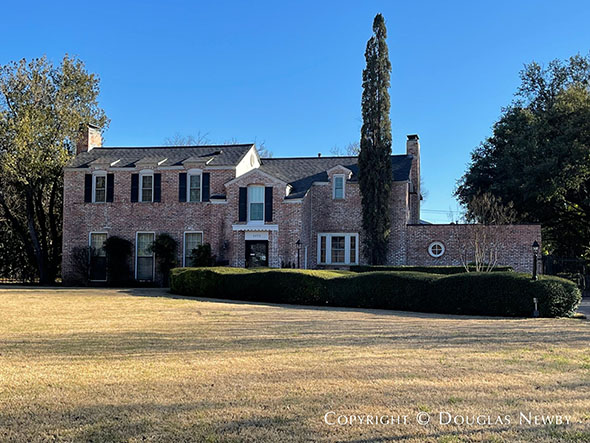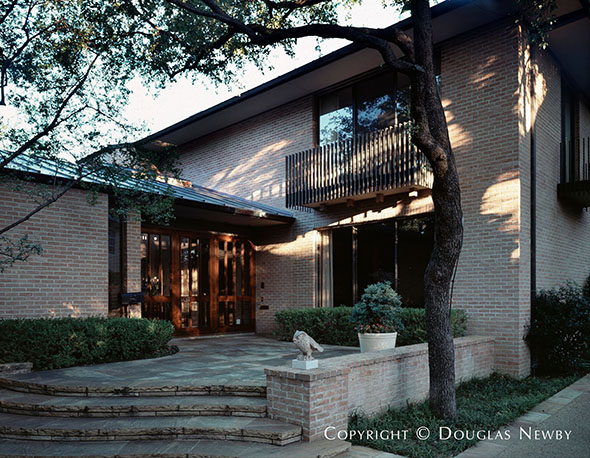
From time to time, we hear of the demolition of an historic or architecturally significant home in the news. Inevitably, there’s an outcry. Community leaders agree: “Something must be done!”
But what can be done?
Unfortunately, by the time these stories hit the news, it is too late to do anything except complain. Huge investments have already been made and approvals set. Instead, preservationists must take proactive steps to that offer advantages to owner of significant homes – and they must take these steps long before the bulldozer arrives.
I’d like to offer five tried and true steps that I have found effective in saving historic and architecturally significant homes over my 45-year professional and civic career.
Step 1: Illuminate the Historic and Architecturally Significant Neighborhoods and Homes in the Community
Step 1 is the most important step. Individual preservationists, neighborhood organizations, architects and preservation groups should identify neighborhoods with homes worth saving, take an inventory and then highlight those homes and their attributes to the public. Make sure everyone in the community knows which homes should be saved and why. I’ve witnessed several powerful instances where steps identifying and illuminating homes and neighborhoods ultimately saved homes.
One successful effort was the creation of a map of a100-block area of Old East Dallas in 1975. At the time, some 2,000 homes in the area were destined for demolition. Most had been divided up, poorly, into apartments. The survey and map showed that the vast majority were originally single-family homes; that helped change the perception of the area, and ultimately convinced the mayor of Dallas, local banks, FNMA, and property owners to support rezoning the area to single-family. This area flourished into what are now three historic districts, and those homes were saved.
Similarly, the annual Dallas Restoration House of the Year Award, started in 1979, the first of its kind in the nation, brought attention to historic neighborhoods and homes and highlighted excellent examples of restoration further preservation of homes.
In 1997, the 50 Significant Homes project totally changed the way people thought about homes in Highland Park, University Park and Dallas. Before this city-wide architectural survey, realtors in Highland Park only talked about who built a home, but never about the architect who designed it. Very few homeowners had any idea who had designed their home. A new interest in architects and architecture brought attention to many homes, and as a result, many were saved.
Step 2: Contact the Homeowners and Cultivate Their Interest in Preserving Their Historic and Architecturally Significant Homes

Owners of this incredibly important David Williams architect-designed home in Old East Dallas have long been committed to making sure the home is preserved and not torn down when it comes time to sell this historic and architecturally significant home. They will be placing architectural deed restrictions on the home when it comes time to sell it.
Just as development officers at universities and museums cultivate potential donors well in advance of a major gift, preservationists should cultivate the owners of historic or architecturally significant homes long before they consider selling. Art museum directors typically are very aware of every privately owned, museum-quality painting or sculpture in their area. Yet surprisingly few owners of architecturally significant homes are approached by preservationists regarding their plans for their homes.
In the same way, individual preservationists, neighborhood organizations, architects and preservation groups can work proactively to cultivate owners of significant homes. Many of these homeowners are wealthy, civic-minded people who donate art or large sums of money to charities, often in amounts greater than the value of their homes. Yet they leave their homes to be discharged by trustees or executors of their estates with little direction. Without specific instructions, an executor is obligated to sell the home as expeditiously as possible. The homeowner may have had great affection for their home, but the surviving children may live out of state and not understand the home’s importance. A proactive preservation plan could allow a homeowner to ultimately distribute more money to their children while also, in effect, donating the preservation of the home to the community.
Saving homes is sometimes as easy as just letting the homeowner know how significant their home is. For example, year ago I happened to meet the new owners of an architecturally significant home in Old Highland Park. They planned to tear the house down and build a new home. After explaining to them the home’s importance – it had just been selected as a Dallas Chapter AIA 50 Significant Home – they agreed. I quietly notified a few key members of the community, who also encouraged the new owners to not tear down the house. Ultimately, the owners sold the house to another buyer who renovated. This lowkey approach was much more effective than just generating public outrage. The midcentury modern home has survived for 15 years, enabling a whole new generation to see a residential example of the work of architect E.G. Hamilton.
Step 3: Encourage Architects and Interior Designers to Create a Vision of a Renovated Home
When architects and interior designers create sketches on how to renovate a specific historic home and optimize its value in the marketplace, it gives home buyers an advantage. Now when a home goes on the market in a highly desired area such as Highland Park, buyers looking for a “lot only” purchase have a distinct advantage. This step helps level the field for buyers who want to renovate. Architects and interior designers with an interest in preservation might donate their services; nonprofits, preservationists and realtors might underwrite these design services to help save the home.
By proactively creating an architectural vision, before the home goes on the market, a buyer desiring to renovate the home is on more equal footing with a “lot only” buyer. An interior designer can also contribute by creating a design board that shows finishes, materials and colors that illustrate the appeal of the space the architect sketched. This gives a homebuyer a quicker understanding of the appeal and viability of the historic home for their contemporary lifestyle.
Early in my career, I realized that Munger Place could only be revitalized if homebuyers could be convinced to buy and renovate the deteriorated houses in the Munger Place neighborhood of Dallas. Each home had been turned into four apartments, each teeming with unseemly weekly tenants, considered virtually impossible to sell. I retained an architect to draw plans of the original single-family floorplan that removed the bathroom in the living room, the three extra kitchens, and added walls. Also, the architect created a pen and ink drawing of what the original facade looked like before a closed-in front porch, with three front doors, had been added. This gave buyers a sense of the home’s original elegance. Every one of these original homes in Munger Place are now renovated and are on the National Register and in the Munger Place Historic District.
Step 4: Determine the Condition of a Home and Approximate Cost of Renovating, Economic Viability, and Value of Home Once Renovated

The Scott Lyons architect-designed home in Highland Park has been saved and is being renovated by sophisticated homeowners who had already renovated another historic home in Highland Park nearby and were aware of the cost and process.
This fourth step is incredibly helpful to buyers, as it takes away much of the uncertainty as to the economic viability of renovating the home. Preservationists might underwrite the cost, or encourage contractors, inspectors and appraisers who have an interest in preservation to donate their services.
A buyer who wants a lot only typically comes to the purchase with cost estimates and house plans from a builder in hand and house plans may already be drawn. This allows a lot buyer to make an offer quickly and close quickly. If the groundwork is done for renovation before a home goes on the market -- an inspector inspects the home, a contractor estimates the cost of renovation, and an appraiser estimates the value of the home once it is fully renovated -- the homebuyer interested in renovation can also make an expedited decision. This buyer might ultimately renovate the home in a different way, but at least the buyer knows the aesthetic and economic parameters with which they are working.
When a homebuyer knows up front the home’s condition and cost of renovation, the faster they can purchase the home.
The seller very likely will obtain a higher price from a buyer wanting to renovate the home.
Step 5: Assist Homeowners in Creating Architectural Deed Restrictions That Allow Renovations but Prevent Architectural Devastations
The previous four steps will boost the chances of saving a home; Step Five will guarantee that the home will be spared from being torn down. Realtors can work with homeowners, attorneys and title companies in this step. Placing architectural deed restrictions and easements on a home is a powerful tool for saving homes. Restrictions and architectural easements can be customized for each home in a way that allows a buyer who appreciates architecturally significant or historic homes to renovate or expand the home in the way they desire, while at the same time preserving the best architectural features of the home. Most important, architectural deed restrictions and easements prevent the historic home from being torn down.
These five steps to saving homes will not save every historic and architecturally significant home, but they will save many significant homes that would not be torn down otherwise.
Douglas Newby is a national award-wining real estate broker and property rights preservationist who writes about real estate, cities, architecture and Organic Urbansim. He gave the TEDx Talk Homes That Make Us Happy. You can read more about him and his work on his website Architecturally SignificantHomes: DougNewby.com and on his blog DouglasNewby.com.
Lead photo: Swiss Avenue, the street on which this Hal Thomson architect designed home is found, is a good example of saving homes by implementing step one and step two of the five preservation steps of saving homes.












